Submitted:
16 June 2023
Posted:
20 June 2023
You are already at the latest version
Abstract
Keywords:
1. Introduction
2. Materials and Methods
2.1. Yeast Strains
2.2. Pilot fermentation Trials
2.3. Monitoring of yeast population
2.4. Analytical Procedures
2.5. Sensory Analysis
2.6. Statistical Analysis
3. Results
3.1. First fermentation trial: evaluation of SO2 addition in T. delbrueckii/S. cerevisiae sequential fermentation
3.1.1. Biomass evolution and biocontrol activity
3.1.2. Main analytical characters
3.1.3. Main volatile compounds
3.2. Second fermentation trial: evaluation and comparison of native T. delbrueckii DiSVA 130 and commercial strain ALPHA® in sequential fermentation with S. cerevisiae DiSVA 709 (no SO2 added)
3.2.1. Biomass evolution and biocontrol action
3.2.2. Main oenological characters
3.2.3. Main oenological volatile compounds
3.3. Sensory analysis of Verdicchio wines inoculated with S. cerevisiae DiSVA 709, T. delbrueckii DiSVA 130/S. cerevisiae DiSVA 709 and T. delbrueckii ALPHA® /S. cerevisiae DiSVA 709
4. Discussion
Author Contributions
Funding
Data Availability Statement
Acknowledgments
Conflicts of Interest
References
- Pretorius, I.S. Tailoring wine yeast for the new millennium: novel approaches to the ancient art of winemaking. Yeast 2000, 16, 675–729. [Google Scholar] [CrossRef] [PubMed]
- Comitini, F.; Capece, A.; Ciani, M.; Romano, P. New insights on the use of wine Yeasts. Current Opinion in Food Science 2017, 13, 44–49. [Google Scholar] [CrossRef]
- Jolly, N.P.; Varela, C.; Pretorius, I.S. Not your ordinary yeast: non-Saccharomyces yeasts in wine production uncovered. FEMS Yeast Res. 2014, 14, 215–237. [Google Scholar] [CrossRef] [PubMed]
- Del Fresno, J.M.; Morata, A.; Loira, I.; Bañuelos, M.A.; Escott, C.; Benito, S.; González Chamorro, C.; Suárez-Lepe, J.A. Use of non-Saccharomyces in single-culture, mixed and sequential fermentation to improve red wine quality. Eur. Food Res. Technol. 2017, 243, 2175–2185. [Google Scholar] [CrossRef]
- Varela, C. The Impact of non-Saccharomyces yeasts in the production of alcoholic beverages. Appl Microbiol Biotechnol 2016, 100, 9861–9874. [Google Scholar] [CrossRef]
- Ciani, M.; Ferraro, L. Combined use of immobilized Candida stellata cells and Saccharomyces cerevisiae to improve the quality of wines. Journal of Applied Microbiology 1998, 85, 247–254. [Google Scholar] [CrossRef]
- Bely, M.; Stoeckle, P.; Masneuf-Pomarède, I.; Dubourdieu, D. Impact of mixed Torulaspora delbrueckii–Saccharomyces cerevisiae culture on high-sugar fermentation. International Journal of Food Microbiology 2008, 122, 312–320. [Google Scholar] [CrossRef]
- Gobbi, M.; Comitini, F.; Domizio, P.; Romani, C.; Lencioni, L.; Mannazzu, I.; Ciani, M. Lachancea thermotolerans and Saccharomyces cerevisiae in simultaneous and sequential co-fermentation: a strategy to enhance acidity and improve the overall quality of wine. Food Microbiology 2013, 33, 271–281. [Google Scholar] [CrossRef]
- Renault, P.; Coulon, J.; Moine, V.; Thibon, C.; Bely, M. Enhanced 3-sulfanylhexan-1-ol production in sequential mixed fermentation with Torulaspora delbrueckii/Saccharomyces cerevisiae reveals a situation of synergistic interaction between two industrial strains. Frontiers in Microbiology 2016, 7. [Google Scholar] [CrossRef]
- Comitini, F.; Gobbi, M.; Domizio, P.; Romani, C.; Lencioni, L.; Mannazzu, I.; Ciani, M. Selected non-Saccharomyces wine yeasts in controlled multistarter fermentations with Saccharomyces cerevisiae. Food Microbiology 2011, 28, 873–882. [Google Scholar] [CrossRef]
- Zhang, B.; Tang, C.; Yang, D.; Liu, H.; Xue, J.; Duan, C.; Yan, G. Effects of three indigenous non-Saccharomyces yeasts and their pairwise combinations in co-fermentation with Saccharomyces cerevisiae on volatile compounds of petit manseng wines. Food Chemistry 2022, 368, 130807. [Google Scholar] [CrossRef]
- Ciani, M.; Morales, P.; Comitini, F.; Tronchoni, J.; Canonico, L.; Curiel, J.A.; Oro, L.; Rodrigues, A.J.; Gonzalez, R. Non-conventional yeast species for lowering ethanol content of wines. Frontiers in Microbiology 2016, 7. [Google Scholar] [CrossRef]
- Divol, B.; du Toit, M.; Duckitt, E. Surviving in the presence of sulphur dioxide: strategies developed by wine yeasts. Appl Microbiol Biotechnol 2012, 95, 601–613. [Google Scholar] [CrossRef] [PubMed]
- Escribano-Viana, R.; González-Arenzana, L.; Garijo, P.; Fernández, L.; López, R.; Santamaría, P.; Gutiérrez, A.R. Bioprotective Effect of a Torulaspora delbrueckii/Lachancea thermotolerans-mixed inoculum in red winemaking. Fermentation 2022, 8, 337. [Google Scholar] [CrossRef]
- Chacon-Rodriguez, L.; Joseph, C.M.L.; Nazaris, B.; Coulon, J.; Richardson, S.; Dycus, D.A. Innovative use of non- Saccharomyces in bio-protection: T. Delbrueckii and M. Pulcherrima Applied to a Machine Harvester. Catalyst: Discovery into Practice 2020, 4, 82–90. [Google Scholar] [CrossRef]
- Morata, A.; Loira, I.; González, C.; Escott, C. Non-Saccharomyces as biotools to control the production of off-flavors in wines. Molecules 2021, 26, 4571. [Google Scholar] [CrossRef]
- Agarbati, A.; Canonico, L.; Ciani, M.; Comitini, F. Metschnikowia pulcherrima in cold clarification: biocontrol activity and aroma enhancement in Verdicchio wine. Fermentation 2023, 9, 302. [Google Scholar] [CrossRef]
- Canonico, L.; Agarbati, A.; Galli, E.; Comitini, F.; Ciani, M. Metschnikowia pulcherrima as biocontrol agent and wine aroma enhancer in combination with a native Saccharomyces cerevisiae. LWT 2023, 181, 114758. [Google Scholar] [CrossRef]
- Simonin, S.; Alexandre, H.; Nikolantonaki, M.; Coelho, C.; Tourdot-Maréchal, R. Inoculation of Torulaspora delbrueckii as a bio-protection agent in winemaking. Food Research International 2018, 107, 451–461. [Google Scholar] [CrossRef]
- Benito, S. The impact of Torulaspora delbrueckii yeast in winemaking. Appl Microbiol Biotechnol 2018, 102, 3081–3094. [Google Scholar] [CrossRef]
- Agarbati, A.; Canonico, L.; Comitini, F.; Ciani, M. Improved Saccharomyces cerevisiae strain in pure and sequential fermentation with Torulaspora delbrueckii for the production of verdicchio wine with reduced sulfites. Applied Sciences 2020, 10, 6722. [Google Scholar] [CrossRef]
- Comitini, F.; Agarbati, A.; Canonico, L.; Ciani, M. Yeast interactions and molecular mechanisms in wine fermentation: a comprehensive review. IJMS 2021, 22, 7754. [Google Scholar] [CrossRef] [PubMed]
- Oro, L.; Canonico, L.; Marinelli, V.; Ciani, M.; Comitini, F. Occurrence of Brettanomyces bruxellensis on grape berries and in related winemaking cellar. Frontiers in Microbiology 2019, 10. [Google Scholar] [CrossRef] [PubMed]
- White, C. i.; Haber, J. e. Intermediates of recombination during mating type switching in Saccharomyces cerevisiae. The EMBO Journal 1990, 9, 663–673. [Google Scholar] [CrossRef]
- Legras, J.-L.; Karst, F. Optimisation of Interdelta Analysis for Saccharomyces cerevisiae strain characterisation. FEMS Microbiology Letters 2003, 221, 249–255. [Google Scholar] [CrossRef]
- Canonico, L.; Comitini, F.; Ciani, M. Influence of vintage and selected starter on Torulaspora delbrueckii/Saccharomyces cerevisiae Sequential Fermentation. Eur Food Res Technol 2015, 241, 827–833. [Google Scholar] [CrossRef]
- Dukes, B.C.; Butzke, C.E. Rapid Determination of primary amino acids in grape juice using an o-phthaldialdehyde/n-acetyl-l-cysteine spectrophotometric assay. Am J Enol Vitic. 1998, 49, 125–134. [Google Scholar] [CrossRef]
- Canonico, L.; Solomon, M.; Comitini, F.; Ciani, M.; Varela, C. Volatile profile of reduced alcohol wines fermented with selected non-Saccharomyces yeasts under different aeration conditions. Food Microbiology 2019, 84, 103247. [Google Scholar] [CrossRef]
- Sun, S.Y.; Jiang, W.G.; Zhao, Y.P. Evaluation of different Saccharomyces cerevisiae strains on the profile of volatile compounds and polyphenols in cherry wines. food chemistry 2011, 127, 547–555. [Google Scholar] [CrossRef]
- Gambetta, J.M.; Bastian, S.E.P.; Cozzolino, D.; Jeffery, D.W. Factors influencing the aroma composition of chardonnay wines. J. Agric. Food Chem. 2014, 62, 6512–6534. [Google Scholar] [CrossRef]
- Ramírez, M.; Velázquez, R. The yeast Torulaspora delbrueckii: an interesting but difficult-to-use tool for winemaking. Fermentation 2018, 4, 94. [Google Scholar] [CrossRef]
- Cabrera, M.J.; Moreno, J.; Ortega, J.M.; Medina, M. Formation of ethanol, higher alcohols, esters, and terpenes by five yeast strains in musts from Pedro Ximénez grapes in various degrees of ripeness. Am J Enol Vitic. 1988, 39, 283–287. [Google Scholar] [CrossRef]
- Takush, D. g.; Osborne, J. p. Impact of yeast on the aroma and flavour of Oregon pinot noir wine. Australian Journal of Grape and Wine Research 2012, 18, 131–137. [Google Scholar] [CrossRef]
- van Breda, V.; Jolly, N.; van Wyk, J. Characterisation of commercial and natural Torulaspora delbrueckii wine yeast strains. International Journal of Food Microbiology 2013, 163, 80–88. [Google Scholar] [CrossRef] [PubMed]
- Zhang, B.; Liu, H.; Xue, J.; Tang, C.; Duan, C.; Yan, G. Use of Torulaspora delbrueckii and Hanseniaspora vineae co-fermentation with Saccharomyces cerevisiae to Improve aroma profiles and safety quality of Petit Manseng wines. LWT 2022, 161, 113360. [Google Scholar] [CrossRef]
- Azzolini, M.; Tosi, E.; Lorenzini, M.; Finato, F.; Zapparoli, G. Contribution to the aroma of white wines by controlled Torulaspora delbrueckii cultures in association with Saccharomyces cerevisiae. World J Microbiol Biotechnol 2015, 31, 277–293. [Google Scholar] [CrossRef]
- Renault, P.; Coulon, J.; de Revel, G.; Barbe, J.-C.; Bely, M. Increase of fruity aroma during mixed T. Delbrueckii/S. cerevisiae Wine fermentation is linked to specific esters enhancement. International Journal of Food Microbiology 2015, 207, 40–48. [Google Scholar] [CrossRef]
 )/ S. cerevisiae DiSVA 709 (
)/ S. cerevisiae DiSVA 709 ( ) and wild yeasts (
) and wild yeasts ( ) on natural grape juice with (a) and without (b) SO2.
) on natural grape juice with (a) and without (b) SO2.
 )/ S. cerevisiae DiSVA 709 (
)/ S. cerevisiae DiSVA 709 ( ) and wild yeasts (
) and wild yeasts ( ) on natural grape juice with (a) and without (b) SO2.
) on natural grape juice with (a) and without (b) SO2.
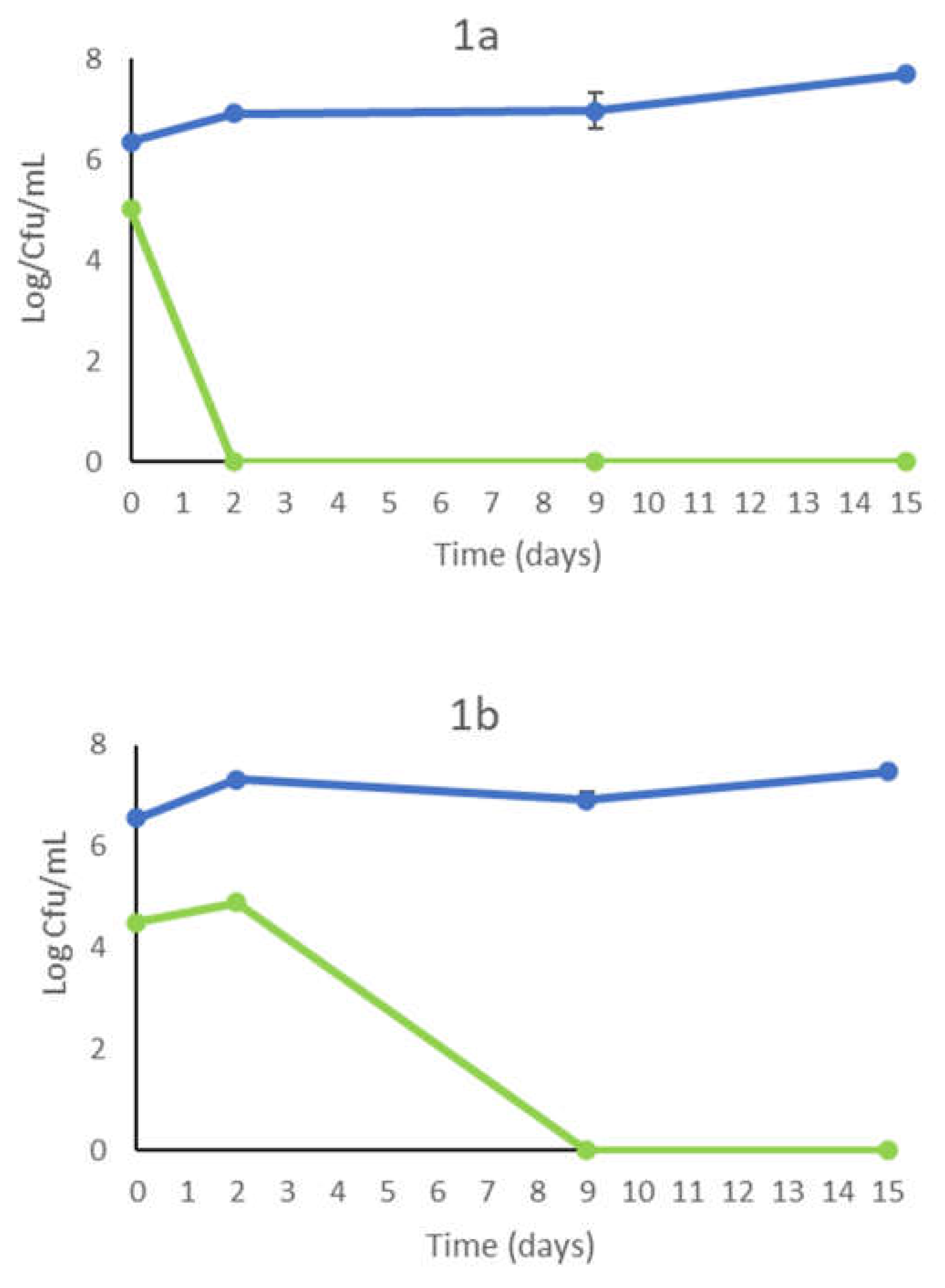
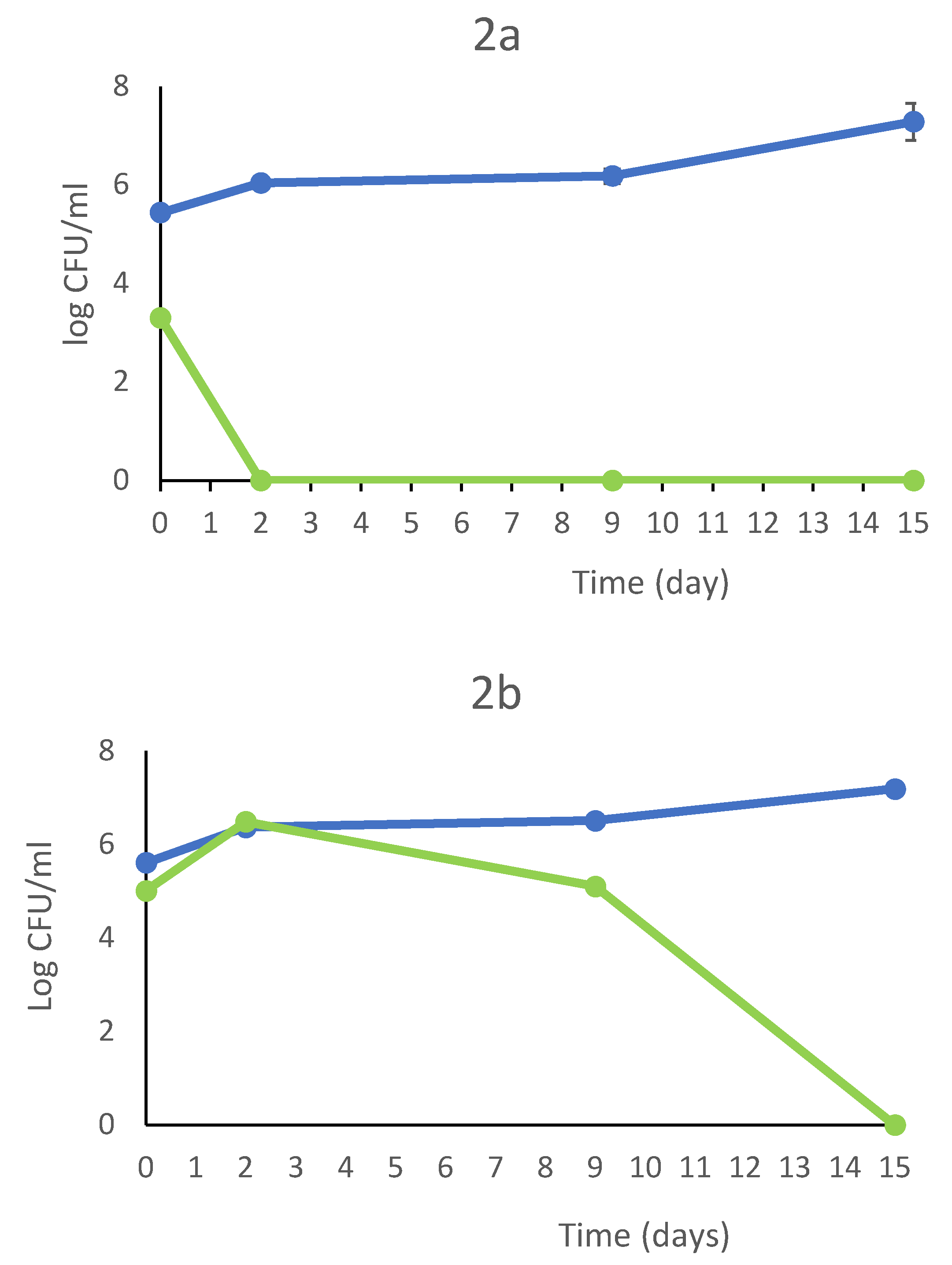
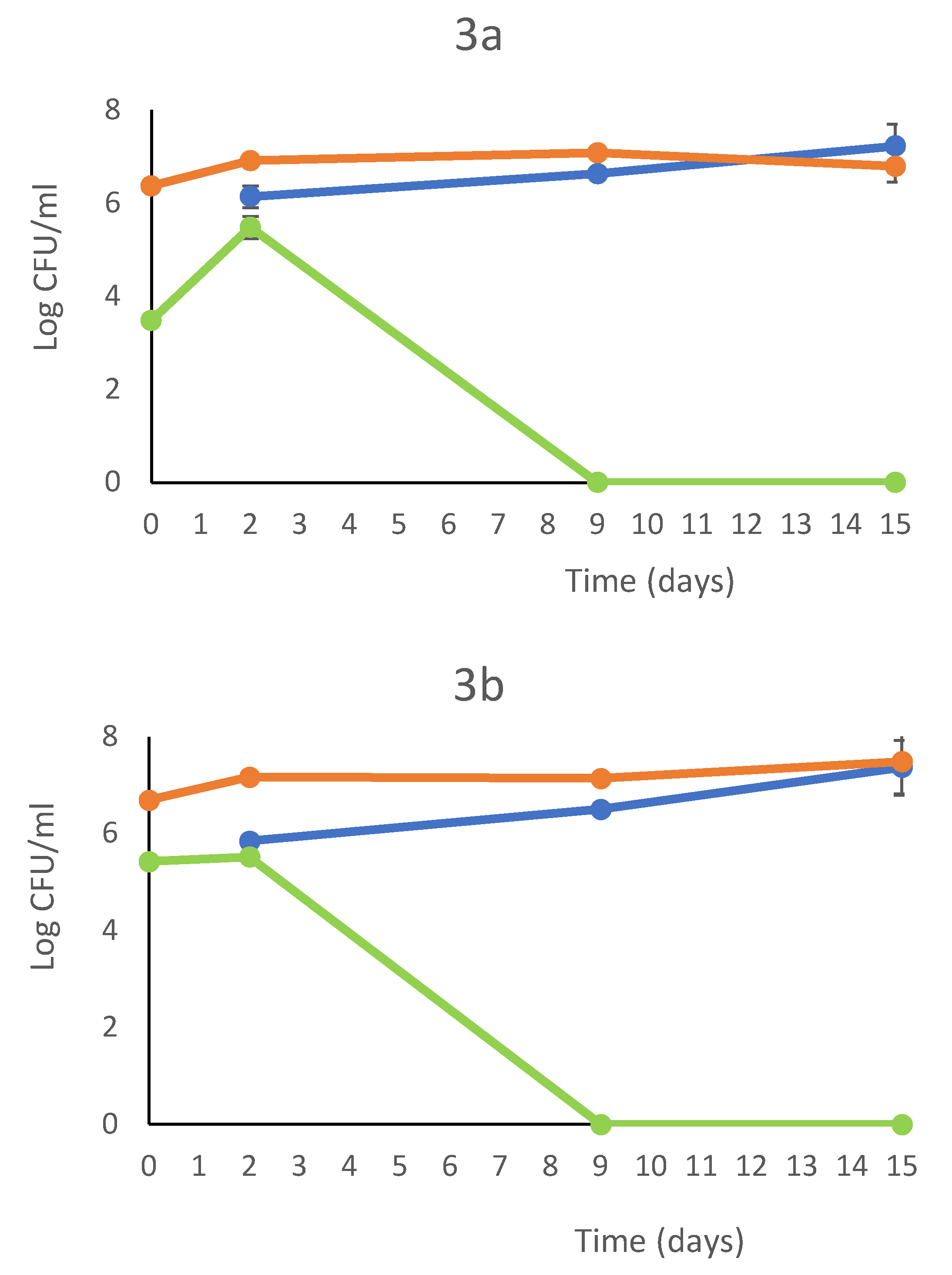
 ), wild yeasts (
), wild yeasts ( )T. delbrueckii (
)T. delbrueckii ( ) on Verdicchio grape juice
) on Verdicchio grape juice
 ), wild yeasts (
), wild yeasts ( )T. delbrueckii (
)T. delbrueckii ( ) on Verdicchio grape juice
) on Verdicchio grape juice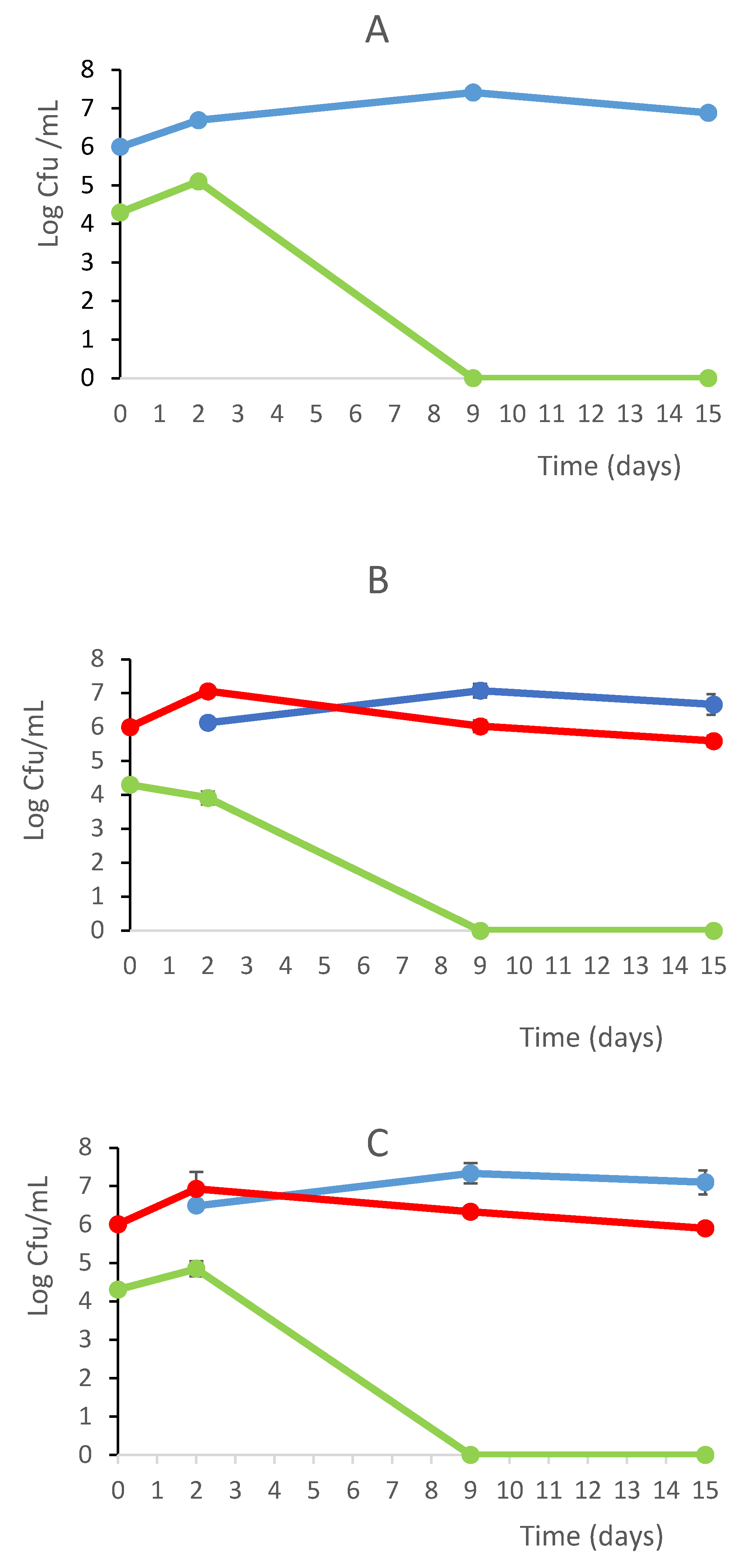
 ); T. delbrueckii DiSVA 130 / S. cerevisiae DiSVA 709 (
); T. delbrueckii DiSVA 130 / S. cerevisiae DiSVA 709 ( ); T. delbrueckii ALPHA® / S. cerevisiae DiSVA 709 (
); T. delbrueckii ALPHA® / S. cerevisiae DiSVA 709 ( ); * Significant difference at P=0.05.
); * Significant difference at P=0.05.
 ); T. delbrueckii DiSVA 130 / S. cerevisiae DiSVA 709 (
); T. delbrueckii DiSVA 130 / S. cerevisiae DiSVA 709 ( ); T. delbrueckii ALPHA® / S. cerevisiae DiSVA 709 (
); T. delbrueckii ALPHA® / S. cerevisiae DiSVA 709 ( ); * Significant difference at P=0.05.
); * Significant difference at P=0.05.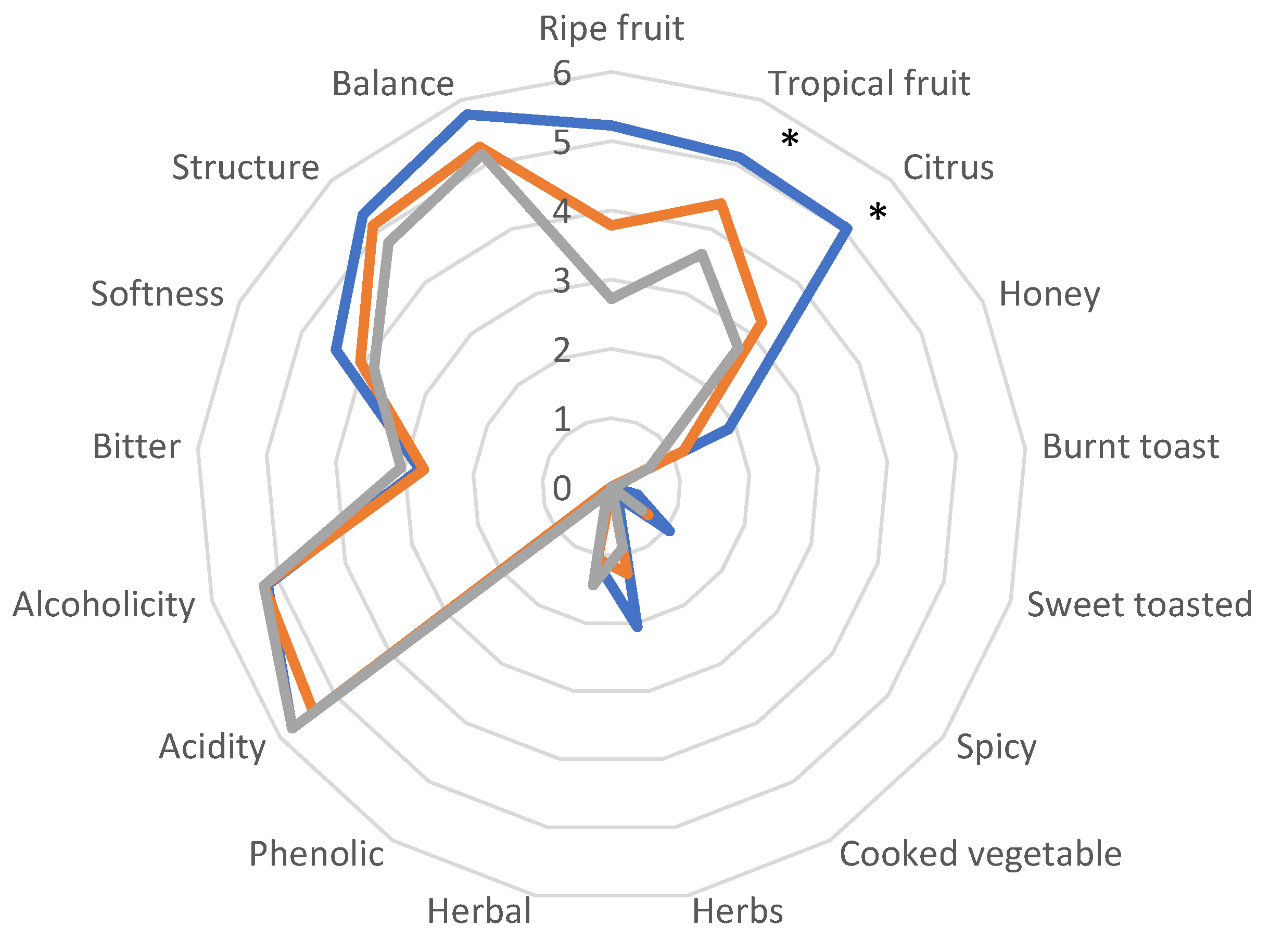
| Inoculated strains | Ethanol (%v/v) |
Total acidity (g/L) |
Volatile acidity (g /L) |
Malic acid (g /L) |
|---|---|---|---|---|
| S. cerevisiae OKAY® +SO2 | 14.69±0.01a | 5.685±0.02c | 0.30±0.00a | 0.9±0.00b |
| S. cerevisiae OKAY® | 14.88± 0.02a | 5.27±0,01c | 0.31±0.014a | 0.7±0.00b |
| S. cerevisiae DiSVA 709 +SO2 | 14.05±0.12b | 6.29±0.05a | 0.225±0.007a | 1.25±0.07a |
| S. cerevisiae DiSVA 709 | 14.35±0.1b | 5.77±0.00ab | 0.305±0.007a | 1± 0.00ab |
| T. delbrueckii DiSVA 130 / S. cerevisiae DiSVA 709 +SO2 | 13.9±0.02c | 6.14±0.14a | 0.25±0.00a | 1.35±0.07b |
| T. delbrueckii DiSVA 130 / S. cerevisiae DiSVA 709 | 13.86±0.09c | 5.355±0.03c | 0.29±0.00a | 0.45±0.07b |
| OKAY® + SO2 |
OKAY® | S. cerevisiae DiSVA 709 +SO2 | S. cerevisiae DiSVA 709 | T. delbrueckii DiSVA 130 /S. cerevisiae DiSVA 709 + SO2 | T. delbrueckii DiSVA 130 / S. cerevisiae DiSVA 709 | |
| ESTERS | ||||||
| Ethyl butyrate (0.02) |
1.214±0.021b | 1.491±0.075a | 0.653±0.223c | 0.628±0.035c | 0.208±0.011d | 0.441±0.084cd |
| Ethyl acetate (7.50 |
19.71±2.17b | 36.35±1.61a | 10.439±0.68b | 38.201±0.86a | 14.18±1.06b | 19.75±0.70b |
| Ethyl exanoate (0.014) |
1.063±0.2354a | 0.16±0.0017b | 0.253±0.0974b | 0.191±0.0110b | 0.081±0.0149b | 0.161±0.0464b |
| Isoamyl acetate (0.03) |
0.947±0.042b | 0.852±0.034b | 1.357±0.462b | 1.095±0.026b | 1.425±0.134b | 3.331±0.375a |
| Phenyl ethyl acetate (0.25) |
0.31±0.01 b | 0.27±0.04 b | 0.64±0.01 a | 0.76±0.04 a | 0.63±0.13 a | 0.79±0.19 a |
| ALCOHOLS | ||||||
| n-propanol (9.0) |
86.630±0.94a | 94.148±1.51a | 39.655± 0.26b | 37.032±2.64b | 27.904±0.71b | 35.734±2.10b |
| Isobutanol (40.0) |
17.51± 0.18b | 12.56±0.63b | 10.957± 2.02b | 19.211±0.52b | 32.634± 0.04a | 25.211± 0.85a |
| Amyl alcohol 1(2.2) |
12.601±2.27b | 12.245±1.51c | 19.211±0.51c | 14.909± 0.08b | 20.74±1.50a | 25.690±0.92a |
| Isoamilic alcohol (30.0) |
132.53±2.18b | 145.105±1.57 b | 137.156±0.99 b | 125.50± 0.13b | 171.56± 2.71a | 192.248±1.68a |
| β-Phenyl ethanol (14.0) |
13.93±0.091bcd | 10.05±0.174cd | 18.90±0.027ab | 15.83±0.212bc | 8.02±0.198d | 25.42±0.649a |
| CARBONYL COMPOUNDS | ||||||
| Acetaldehyde (0.5) |
6.40±2.832ab | 3.23±0.146b | 8.22±0.315a | 7.70±1.855a | 4.79±0.506ab | 3.02±0.678b |
| TERPENS | ||||||
| Linalool (0.025) |
0.197±0.0792a | 0.125±0.0636a | 0.153±0.1189a | 0.186±0.1320a | 0.078±0.0144a | 0.128±0.0119a |
| Geraniol (0.030) |
0.009±0.0004abc | 0.007±0.0028bc | 0.016±0.0029a | 0.013±0.0039ab | 0.003±0.0036c | 0.013±0.0046ab |
| Nerol (0.025) |
0.006±0.0036ab | 0.004±0.0059ab | ND** | 0.009±0.0019 ab. | 0.011±0.0045a | 0.008±0.0022ab |
| Ethanol (%v/v) |
Total acidity (g /L) |
Volatile acidity (g/ L) |
Malic acid (g/ L) |
|
|---|---|---|---|---|
| S. cerevisiae DiSVA 709 | 14.43±0.00a | 5.52±0.02a | 0.25±0.063a | 1.2±0.00a |
| T. delbrueckii DiSVA 130 /S. cerevisiae DiSVA 709 | 13.77± 0.10b | 5.55±0.14a | 0.23±0.007a | 1.2±0.14a |
| T. delbrueckii ALPHA®/ S. cerevisiae DiSVA 709 | 13.71±0.02b | 5.52±0.06a | 0.25±0.028a | 1.1±0.00a |
|
S. cerevisiae DiSVA 709 mg/L |
T. delbrueckii DiSVA 130 / S. cerevisiae DiSVA 709 mg/L | T. delbrueckii ALPHA® / S. cerevisiae DiSVA 709 mg/L | |
| ESTERS | |||
| Ethyl butyrate (0.02) |
0.40±0.10b | 0.31 ± 0.01c | 0.52±0.19a |
| Ethyl acetate (7.50) |
26.42±4.29b | 59.88±2.14a | 33.67±6.71b |
| Ethyl exanoate (0.014) |
2.76±0.33b | 2.90±0.41ab | 3.39±0.35a |
| Isoamyl acetate (0.03) |
0.90±0.01b | 0.95±0.08a | 1.03±0.04a |
| Phenylethyl acetate (0.25) |
0.08±0.01c | 0.74±0.16b | 0.98±0.08a |
| ALCOHOLS | |||
| n-propanol (9.0) |
37.01±3.09a | 39.25±1.40a | 38.73±0.79a |
| Isobutanol (40.0) |
15.38±1.72b | 26.67±5.20a | 11.92±3.30c |
| Amyl alcohol (12.2) |
12.99±0.26b | 39.76±8.28a | 14.33±3.77b |
| Isoamylic alcohol (30.0) |
123.34±8.0a | 67.11±5.45b | 126.30±2.7a |
| β-Phenyl ethanol (14.0) |
7.45±0.01b | 7.40±0.16b | 9.10±0.02a |
| CARBONYL COMPOUNDS | |||
| Acetaldehyde (0.50) |
19.23±0.50a | 14.25±0.27b | 14.23±2.87b |
| MONOTERPENS | |||
| Linalool (0.025) |
0.03±000b | 0.20±0.07a | 0.22±0.14a |
| Geraniol (0.030) |
0±0.000c | 0.006±0.00a | 0.003±0.00b |
| Nerol (0.025) |
0.003±0.001b | 0.004±0.00b | 0.006±0.00a |
Disclaimer/Publisher’s Note: The statements, opinions and data contained in all publications are solely those of the individual author(s) and contributor(s) and not of MDPI and/or the editor(s). MDPI and/or the editor(s) disclaim responsibility for any injury to people or property resulting from any ideas, methods, instructions or products referred to in the content. |
© 2023 by the authors. Licensee MDPI, Basel, Switzerland. This article is an open access article distributed under the terms and conditions of the Creative Commons Attribution (CC BY) license (http://creativecommons.org/licenses/by/4.0/).





